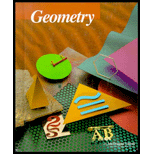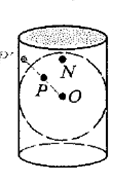
Concept explainers
To find: The distances near the equator distorted more than or less than distances near the Arctic
Answer to Problem 18WE
The image of equator and Arctic Circle will be congruent.
Explanation of Solution
Given information:
It is given that a piece of paper is wrapped around a globe of earth to form a cylinder as shown.

Calculation:
If the equator is the line of latitude that is the longest and lie along the circumference of the globe and divides the globe into the northern and southern hemisphere, the images of all points on the equator will lies on the paper as circle.
Similarly, Arctic Circle is one of the five major circles of latitude the images of all points of the Arctic Circle will lies on the paper in a form of circle. And because of the shape of the paper, a cylindrical shape, the circles will be congruent.
As the actual line of Arctic Circle on globe is smaller than the equator line but on the paper, their images are congruent with each other. Therefore, as the point moves from equator to Arctic Circle the distance distorted.
Thus, the distance near the equator is less distorted than distances near the Arctic Circle.
Therefore, the distance near the equator is less distorted than distances near the Arctic Circle.
Chapter 14 Solutions
McDougal Littell Jurgensen Geometry: Student Edition Geometry
Additional Math Textbook Solutions
Thinking Mathematically (6th Edition)
Algebra and Trigonometry (6th Edition)
Elementary Statistics: Picturing the World (7th Edition)
Intro Stats, Books a la Carte Edition (5th Edition)
A First Course in Probability (10th Edition)
Calculus: Early Transcendentals (2nd Edition)
 Elementary Geometry For College Students, 7eGeometryISBN:9781337614085Author:Alexander, Daniel C.; Koeberlein, Geralyn M.Publisher:Cengage,
Elementary Geometry For College Students, 7eGeometryISBN:9781337614085Author:Alexander, Daniel C.; Koeberlein, Geralyn M.Publisher:Cengage, Elementary Geometry for College StudentsGeometryISBN:9781285195698Author:Daniel C. Alexander, Geralyn M. KoeberleinPublisher:Cengage Learning
Elementary Geometry for College StudentsGeometryISBN:9781285195698Author:Daniel C. Alexander, Geralyn M. KoeberleinPublisher:Cengage Learning

